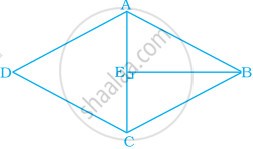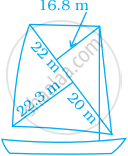Advertisements
Advertisements
प्रश्न
If the diagonals of a rhombus get doubled, then the area of the rhombus becomes ______ its original area.
उत्तर
If the diagonals of a rhombus get doubled, then the area of the rhombus becomes 4 times its original area.
Explanation:
We know that,
Area of a rhombus = `1/2 xx d_1 xx d_2`
Where, d1 and d2 are diagonals of the rhombus.
If diagonals get doubled, then the area = `1/2 2d_1 xx 2d_2 = 4(1/2 xx d_1 xx d_2)`
Hence, the new area becomes 4 times its original area.
APPEARS IN
संबंधित प्रश्न
Each side of a rhombus is 18 cm. If the distance between two parallel sides is 12 cm, find its area.
The diagonals of a rhombus are 18 cm and 24 cm. Find:
(i) its area ;
(ii) length of its sides.
(iii) its perimeter
Find the missing value.
| Diagonal (d1) | Diagonal (d2) | Area |
| 12 mm | 180 sq.mm |
The area of a rhombus is 100 sq.cm and length of one of its diagonals is 8 cm. Find the length of the other diagonal
The height of the rhombus whose area 96 sq.m and side 24 m is
What is the area of the rhombus ABCD below if AC = 6 cm and BE = 4 cm?

Area of a quadrilateral ABCD is 20 cm2 and perpendiculars on BD from opposite vertices are 1 cm and 1.5 cm. The length of BD is ______.
Area of a rhombus = `1/2` product of ______.
The walls and ceiling of a room are to be plastered. The length, breadth and height of the room are 4.5 m, 3 m, and 350 cm respectively. Find the cost of plastering at the rate of Rs 8 per m2.
Most of the sailboats have two sails, the jib and the mainsail. Assume that the sails are triangles. Find the total area sail of the sailboats to the nearest tenth.

